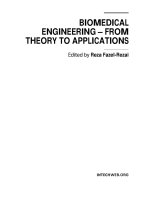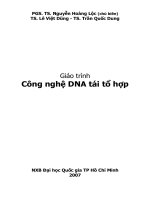Sinusitis From Microbiology to Management - part 1 pdf
Bạn đang xem bản rút gọn của tài liệu. Xem và tải ngay bản đầy đủ của tài liệu tại đây (1.38 MB, 49 trang )
Sinusitis
From Microbiology
to Management
DK3789_half-series-title.qxd 7/19/05 3:26 PM Page 1
INFECTIOUS DISEASE AND THERAPY
Series Editor
Burke A. Cunha
Winthrop-University Hospital
Mineola, and
State University of New York School of Medicine
Stony Brook, New York
1. Parasitic Infections in the Compromised Host,
edited by Peter D. Walzer and Robert M. Genta
2. Nucleic Acid and Monoclonal Antibody Probes:
Applications in Diagnostic Methodology,
edited by
Bala Swaminathan and Gyan Prakash
3. Opportunistic Infections in Patients with the Acquired
Immunodeficiency Syndrome,
edited by
Gifford Leoung and John Mills
4. Acyclovir Therapy for Herpesvirus Infections,
edited by
David A. Baker
5. The New Generation of Quinolones,
edited by
Clifford Siporin, Carl L. Heifetz, and John M. Domagala
6. Methicillin-Resistant
Staphylococcus aureus
: Clinical
Management and Laboratory Aspects,
edited by
Mary T. Cafferkey
7. Hepatitis B Vaccines in Clinical Practice,
edited by
Ronald W. Ellis
8. The New Macrolides, Azalides, and Streptogramins:
Pharmacology and Clinical Applications,
edited by
Harold C. Neu, Lowell S. Young, and Stephen H. Zinner
9. Antimicrobial Therapy in the Elderly Patient,
edited by
Thomas T. Yoshikawa and Dean C. Norman
10. Viral Infections of the Gastrointestinal Tract:
Second Edition, Revised and Expanded,
edited by
Albert Z. Kapikian
11. Development and Clinical Uses of
Haemophilus b
Conjugate Vaccines,
edited by Ronald W. Ellis
and Dan M. Granoff
12.
Pseudomonas aeruginosa
Infections and Treatment,
edited by Aldona L. Baltch and Raymond P. Smith
DK3789_half-series-title.qxd 7/19/05 3:26 PM Page 2
13. Herpesvirus Infections,
edited by Ronald Glaser
and James F. Jones
14. Chronic Fatigue Syndrome,
edited by
Stephen E. Straus
15. Immunotherapy of Infections,
edited by K. Noel Masihi
16. Diagnosis and Management of Bone Infections,
edited by Luis E. Jauregui
17. Drug Transport in Antimicrobial and Anticancer
Chemotherapy,
edited by Nafsika H. Georgopapadakou
18. New Macrolides, Azalides, and Streptogramins in
Clinical Practice,
edited by Harold C. Neu,
Lowell S. Young, Stephen H. Zinner,
and Jacques F. Acar
19. Novel Therapeutic Strategies in the Treatment of
Sepsis,
edited by David C. Morrison and John L. Ryan
20. Catheter-Related Infections,
edited by Harald Seifert,
Bernd Jansen, and Barry M. Farr
21. Expanding Indications for the New Macrolides,
Azalides, and Streptogramins,
edited by
Stephen H. Zinner, Lowell S. Young, Jacques F. Acar,
and Harold C. Neu
22. Infectious Diseases in Critical Care Medicine,
edited by Burke A. Cunha
23. New Considerations for Macrolides, Azalides,
Streptogramins, and Ketolides,
edited by
Stephen H. Zinner, Lowell S. Young, Jacques F. Acar,
and Carmen Ortiz-Neu
24. Tickborne Infectious Diseases: Diagnosis
and Management,
edited by Burke A. Cunha
25. Protease Inhibitors in AIDS Therapy,
edited by
Richard C. Ogden and Charles W. Flexner
26. Laboratory Diagnosis of Bacterial Infections,
edited by Nevio Cimolai
27. Chemokine Receptors and AIDS,
edited by
Thomas R. O’Brien
28. Antimicrobial Pharmacodynamics in Theory
and Clinical Practice,
edited by Charles H. Nightingale,
Takeo Murakawa, and Paul G. Ambrose
29. Pediatric Anaerobic Infections: Diagnosis and
Management, Third Edition, Revised and Expanded,
Itzhak Brook
DK3789_half-series-title.qxd 7/19/05 3:26 PM Page 3
30. Viral Infections and Treatment,
edited by
Helga Ruebsamen-Waigmann, Karl Deres, Guy Hewlett,
and Reinhold Welker
31. Community-Aquired Respiratory Infections,
edited by
Charles H. Nightingale, Paul G. Ambrose,
and Thomas M. File
32. Catheter-Related Infections: Second Edition,
Harald Seifert, Bernd Jansen and Barry Farr
33. Antibiotic Optimization: Concepts and Strategies in
Clinical Practice (PBK),
edited by Robert C. Owens, Jr.,
Charles H. Nightingale and Paul G. Ambrose
34. Fungal Infections in the Immunocompromised Patient,
edited by John R. Wingard and Elias J. Anaissie
35. Sinusitis: From Microbiology to Management,
edited by Itzhak Brook
36. Herpes Simplex Viruses,
edited by Marie Studahl,
Paola Cinque and Tomas Bergström
37. Antiviral Agents, Vaccines, and Immunotherapies,
Stephen K. Tyring
DK3789_half-series-title.qxd 7/19/05 3:26 PM Page 4
Sinusitis
From Microbiology
to Management
edited by
Itzhak Brook
Georgetown University School of Medicine
Washington, D.C., U.S.A.
New York London
DK3789_half-series-title.qxd 7/19/05 3:26 PM Page 5
Published in 2006 by
Taylor & Francis Group
270 Madison Avenue
New York, NY 10016
© 2006 by Taylor & Francis Group, LLC
No claim to original U.S. Government works
Printed in the United States of America on acid-free paper
10987654321
International Standard Book Number-10: 0-8247-2948-X (Hardcover)
International Standard Book Number-13: 978-0-8247-2948-6 (Hardcover)
This book contains information obtained from authentic and highly regarded sources. Reprinted material is
quoted with permission, and sources are indicated. A wide variety of references are listed. Reasonable efforts
have been made to publish reliable data and information, but the author and the publisher cannot assume
responsibility for the validity of all materials or for the consequences of their use.
No part of this book may be reprinted, reproduced, transmitted, or utilized in any form by any electronic,
mechanical, or other means, now known or hereafter invented, including photocopying, microfilming, and
recording, or in any information storage or retrieval system, without written permission from the publishers.
For permission to photocopy or use material electronically from this work, please access www.copyright.com
( or contact the Copyright Clearance Center, Inc. (CCC) 222 Rosewood Drive,
Danvers, MA 01923, 978-750-8400. CCC is a not-for-profit organization that provides licenses and registration
for a variety of users. For organizations that have been granted a photocopy license by the CCC, a separate
system of payment has been arranged.
Trademark Notice: Product or corporate names may be trademarks or registered trademarks, and are used only
for identification and explanation without intent to infringe.
Library of Congress Cataloging-in-Publication Data
Catalog record is available from the Library of Congress
Visit the Taylor & Francis Web site at
Taylor & Francis Group
is the Academic Division of T&F Informa plc.
DK3789_Discl.fm Page 1 Wednesday, August 3, 2005 8:27 AM
This book is dedicated to my wife, Joyce, and my children,
Dafna, Tamar, Yoni, and Sara
Preface
Upper respiratory tract infections and, especially, sinusitis are frequently
encountered in the day-to-day practice of infectious disease specialists, aller-
gists, pediatricians, otolaryngologists, internists, and family practitioners.
The range of causative agents and available therapies and the constantly
changing spectrum of antibiotic resistance can make it difficult to select
the most appropriate course of treatment. Given the increasing global con-
cerns regarding the scale of worldwide bacterial resistance, which is largely
because of the misuse and overuse of antibiotics, information that can
enable physicians to optimize management of infections such as sinusitis will
be of great value.
This book provides state-of-the-art information on management of
sinusitis tailored to the clinicians and health care providers of varied special-
ties. It contains a liberal number of figures and tables that clarify the
underlying concepts and illustrate specific details. The authors selected to
contribute to the book are the world experts and leaders in the topic(s) they
address.
The book opens wi th a comprehensive overview of the epidemiology,
clinical presentation, and diagnostic techniques of sinusitis. It then delves
into the pathophysiology and the microbiology underlying the condition.
The next section of the book addresses the medical management of acute
and chronic sinusitis as well as the comorbid medical symptoms. We then
conclude with the surgical management of these conditions and their com-
plications. It is our hope that this book will be a useful tool and an impor-
tant resource for clinicians in the management of sinusitis.
Itzhak Brook, M.D., M.Sc.
v
Contents
Preface . . . . v
Contributors . . . . xv
SECTION I. EPIDEMIOLOGY, PRESENTATION
AND DIAGNOSIS
1. Sinusitis: Epidemiology 1
Thomas M. File Jr.
Introduction . . . . 1
Prevalence and Burden of Disease . . . . 2
Epidemiology and Risk Factors . . . . 5
Pathogens of Bacterial Sinusitis . . . . 10
Sinusitis and HIV . . . . 11
Nosocomial Sinusitis . . . . 12
References . . . . 13
2. Classification of Rhinosinusitis . . . . . 15
Peter A. R. Clement
Introduction . . . . 15
Classifications of Sinusitis . . . . 17
The Classification of Fungal Sinusitis . . . . 28
The Classification of Pediatric Rhinosinusitis . . . . 32
References . . . . 34
vii
3. Rhinosinusitis: Clinical Presentation and Diagnosis . . . . . . 39
Michael S. Benninger and Joshua Gottschall
Introduction . . . . 39
Definitions . . . . 40
Pathophysiology . . . . 41
Rhinosinusitis or Upper Respiratory Tract Infection? . . . . 42
Diagnosis of Rhinosinusitis . . . . 43
Conclusion . . . . 52
References . . . . 52
4. Imaging Sinusitis . . . 55
Nafi Aygun, Ovsev Uzunes, and S. James Zinreich
Introduction . . . . 55
Available Imaging Modalities . . . . 55
Anatomy . . . . 60
Imaging Rhinosinusitis . . . . 71
Presurgical Imaging Evaluation . . . . 84
Postsurgical Imaging Evaluation . . . . 87
Surgical Complications . . . . 87
Computer-Aided Surgery . . . . 89
References . . . . 89
SECTION II. ANATOMY AND PATHOPHYSIOLOGY
5. Anatomy and Physiology of the Paranasal Sinuses . . . . . . 95
John H. Krouse and Robert J. Stachler
Introduction . . . . 95
Embryology of the Nose and Paranasal Sinuses . . . . 96
Anatomy of the Nose and Paranasal Sinuses . . . . 100
Physiology of the Nose and Paranasal Sinuses . . . . 106
Conclusion . . . . 108
References . . . . 108
6. Pathophysiology of Sinusitis . . 109
Alexis H. Jackman and David W. Kennedy
Introduction . . . . 109
Definitions of Rhinosinusitis . . . . 113
Acute Rhinosinusitis . . . . 113
Chronic Rhinosinusitis . . . . 116
Etiologies of Chronic Rhinosinusitis . . . . 117
viii Contents
Summary . . . . 128
References . . . . 129
SECTION III. MICROBIOLOGY
7. Infective Basis of Acute and Recurrent Acute Sinusitis . . . 135
Ellen R. Wald
Introduction . . . . 135
Obtaining Specimens . . . . 135
Microbiology of Acute Sinusitis in Children . . . . 137
Microbiology of Acute Community-Acquired Sinusitis in
Adults . . . . 138
Conclusion . . . . 141
References . . . . 142
8. Infectious Causes of Sinusitis . . . . . . 145
Itzhak Brook
Introduction . . . . 145
The Oral Cavity Normal Flora . . . . 145
Interfering Flora . . . . 151
Nasal Flora . . . . 152
Normal Sinus Flora . . . . 153
Microbiology of Sinusitis . . . . 154
The Role of Fungi in Sinusitis . . . . 167
Conclusion . . . . 169
References . . . . 169
SECTION IV. THERAPEUTIC OPTIONS
9. Antimicrobial Management of Sinusitis . . . . . . 179
Itzhak Brook
Introduction . . . . 179
Antimicrobial Resistance . . . . 179
Beta-Lactamase Production . . . . 180
Antimicrobial Agents . . . . 186
Principles of Therapy . . . . 193
Conclusions . . . . 198
References . . . . 198
Contents ix
10. Medical Management of Acute Sinusitis . 203
Dennis A. Conrad
Introduction . . . . 203
Rationale for the Recommended Management of Acute
Bacterial Sinusitis . . . . 204
Current Recommendations for the Management of Acute
Bacterial Sinusitis . . . . 211
References . . . . 216
11. Medical Management of Chronic Rhinosinusitis . . . . . . . 219
Alexander G. Chiu and Daniel G. Becker
Definition of CRS . . . . 220
Inciting Factors in Sinusitis . . . . 220
Antimicrobial Therapy . . . . 220
Antimicrobial Agents . . . . 221
Anti-inflammatory Agents . . . . 222
Adjunctive Therapy . . . . 223
Maximal Medical Therapy for CRS . . . . 224
Infections Following Functional Endoscopic
Sinus Surgery . . . . 225
Nebulized Medications . . . . 226
Topical Antibiotic Irrigations . . . . 227
Intravenous Antibiotics . . . . 227
Aspirin Desensitization . . . . 229
Conclusion . . . . 229
References . . . . 229
12. Surgical Management . . . . . . 233
David Lewis and Nicolas Y. Busaba
Introduction . . . . 233
Diagnostic Work-Up . . . . 234
Indications for Paranasal Sinus Surgery . . . . 236
Contraindications for Paranasal Sinus Surgery . . . . 238
Endoscopic (Endonasal) Sinus Surgery . . . . 238
Complications of Endoscopic Sinus Surgery . . . . 245
Image Guidance Systems . . . . 247
Microdebriders and Sinus Surgery . . . . 248
Types of Paranasal Sinus Surgery . . . . 249
Antibiotic Coverage in Paranasal Sinus Surgery: Prophylactic
and Post Surgery . . . . 264
x Contents
Lasers and Sinus Surgery . . . . 265
Conclusion . . . . 265
References . . . . 266
13. Complications of Acute and Chronic Sinusitis and Their
Management . 269
Gary Schwartz and Steve White
Introduction . . . . 269
Pathophysiology . . . . 270
Local Complications . . . . 270
Orbital Infections . . . . 272
Intracranial Complications of Sinusitis . . . . 278
References . . . . 288
SECTION V. SINUSITIS AND SPECIFIC DISEASES
14. Sinusitis and Asthma . . 291
Frank S. Virant
Introduction . . . . 291
Historical Association of Sinusitis and Asthma . . . . 291
Chemical, Cytokine, and Cellular Mediators of Airway
Disease . . . . 292
Impact of Medical Sinus Therapy on Asthma . . . . 294
Impact of Surgical Sinus Therapy on Asthma . . . . 294
Sinusitis as a Trigger for Asthma—Mechanisms . . . . 295
Clinical Implications . . . . 297
Conclusions . . . . 300
References . . . . 300
15. Rhinosinusitis and Allergy . . . . . . . . 305
Desiderio Passa
`
li, Valerio Damiani, Giulio Cesare Passa
`
li,
Francesco Maria Passa
`
li, and Luisa Bellussi
Epidemiology . . . . 305
Pathophysiology . . . . 306
Diagnosis . . . . 308
Treatment . . . . 310
Prevention . . . . 313
References . . . . 314
Contents xi
16. Nosocomial Sinusitis 319
Viveka Westergren and Urban Forsum
Introduction . . . . 319
Etiology and Pathogenesis . . . . 320
Epidemiology . . . . 328
Diagnosis of an Infectious Sinusitis in the ICU . . . . 339
Microbiology and Choice of Antimicrobials . . . . 342
Treatment . . . . 345
Complications . . . . 346
Prevention . . . . 347
References . . . . 348
17. Cystic Fibrosis and Sinusitis . . 357
Noreen Roth Henig
Introduction . . . . 357
Pathophysiology of CF . . . . 357
Pathophysiology of CF-Related Sinusitis . . . . 358
Microbiology . . . . 359
Clinical Overview of CF Sinusitis . . . . 361
Diagnosis of Cystic Fibrosis . . . . 363
Treatment of CF-Related Sinusitis . . . . 363
Experimental Therapies . . . . 366
Special Considerations . . . . 367
Conclusion . . . . 367
References . . . . 368
18. Chronic Rhinosinusitis With and Without
Nasal Polyposis . . . . 371
Joel M. Bernstein
Introduction . . . . 371
Potential Etiologies for the Early Stages of CRS . . . . 373
Microbiology . . . . 374
Epidemiology of CRS with Massive Nasal
Polyposis . . . . 375
The Clinical Diagnosis of Nasal Polyposis . . . . 377
Medical and Surgical Therapy of Nasal Polyposis . . . . 380
Pathogenesis of CRS . . . . 381
Conclusions . . . . 397
References . . . . 398
xii Contents
19. Sinusitis of Odontogenic Origin . . . . 403
Itzhak Brook and John Mumford
Introduction . . . . 403
Pathophysiology . . . . 403
Microbiology . . . . 407
Symptoms . . . . 411
Diagnosis . . . . 412
Management . . . . 412
Summary . . . . 415
References . . . . 416
20. Fungal Sinusitis . . . . . . 419
Carol A. Kauffman
Introduction . . . . 419
Epidemiology . . . . 420
Pathogenesis . . . . 422
Diagnosis . . . . 424
Treatment . . . . 428
Conclusions . . . . 432
References . . . . 433
21. Sinusitis in Immunocompromised, Diabetic, and Human
Immunodeficiency Virus–Infected Patients . . . . 437
Todd D. Gleeson and Catherine F. Decker
Introduction . . . . 437
Sinusitis in Neutropenic Patients . . . . 438
Sinusitis in Diabetic Patients . . . . 444
Sinusitis in HIV-Infected Patients . . . . 446
Conclusion . . . . 449
References . . . . 450
Index . . . . 455
Contents xiii
Contributors
Nafi Aygun The Russell H. Morgan Department of Radiology and
Radiological Sciences, The Johns Hopkins Medical Institution, Baltimore,
Maryland, U.S.A.
Daniel G. Becker Department of Otorhinolaryngology—Head and Neck
Surgery, University of Pennsylvania, Philadelphia, Pennsylvania, U.S.A.
Luisa Bellussi Ear, Nose, and Throat Department—University of Siena
Medical School, Viale Bracci, Siena, Italy
Michael S. Benninger Department of Otolaryngology–Head and Neck
Surgery, Henry Ford Hospital, Detroit, Michigan, U.S.A.
Joel M. Bernstein Departments of Otolaryngology and Pediatrics, School
of Medicine and Biomedical Sciences, Department of Communicative
Disorders and Sciences, State University of New York at Buffalo, Buffalo,
New York, U.S.A.
Itzhak Brook Departments of Pediatrics and Medicine, Georgetown
University School of Medicine, Washington, D.C., U.S.A.
Nicolas Y. Busaba Department of Otolaryngology, Harvard Medical
School, VA Boston Healthcare System, Massachusetts Eye and Ear
Infirmary, Boston, Massachusetts, U.S.A.
Alexander G. Chiu Division of Rhinology, Department of
Otorhinolaryngology— Head and Neck Surgery, University of
Pennsylvania, Philadelphia, Pennsylvania, U.S.A.
xv
Peter A. R. Clemen t Department of Otorhinolaryngology and ENT
Department, University Hospital, Free University Brussels (VUB), Brussels,
Belgium
Dennis A. Conrad Division of Infectious Diseases, Department of
Pediatrics, University of Texas Health Science Center at San Antonio,
San Antonio, Texas, U.S.A.
Valerio Damiani Ear, Nose, and Throat Department—University of Siena
Medical School, Viale Bracci, Siena, Italy
Catherine F. Decker Division of Infectious Diseases, Department of
Internal Medicine, National Naval Medical Center, Bethesda, Maryland,
U.S.A.
Thomas M. File, Jr. Northeastern Ohio Universities College of Medicine,
Rootstown, and Infectious Disease Service, Summa Health Service, Akron,
Ohio, U.S.A.
Urban Forsum Division of Clinical Microbiology, Department of
Molecular and Clinical Medicine, Faculty of Health Sciences, Linko
¨
ping
University, Linko
¨
ping, Sweden
Todd D. Gleeson Division of Infectious Diseases, Department of Internal
Medicine, National Naval Medical Center, Bethesda, Maryland, U.S.A.
Joshua Gottschall Department of Otolaryngology–Head and Neck
Surgery, Henry Ford Hospital, Detroit, Michigan, U.S.A.
Noreen Roth Henig Adult Cystic Fibrosis Center, Advanced Lung Disease
Center, California Pacific Medical Center, San Francisco, California,
U.S.A.
Alexis H. Jackman Department of Otorhinolaryngology Head and
Neck Surgery, University of Pennsylvania, Philadelphia, Pennsylvania,
U.S.A.
Carol A. Kauffman Division of Infectious Diseases, University of
Michigan Medical School, Veterans Affairs Ann Arbor Healthcare System,
Ann Arbor, Michigan, U.S.A.
David W. Kennedy Department of Otorhinolaryngology Head and Neck
Surgery, University of Pennsylvania, Philadelphia, Pennsylvania, U.S.A.
xvi Contributors
John H. Krouse Department of Otolaryngology Head and Neck Surgery,
Wayne State University, Detroit, Michigan, U.S.A.
David Lewis Department of Otolaryngology, Harvard Medical School,
Massachusetts Eye and Ear Infirmary, Boston, Massachusetts, U.S.A.
John Mumford Department of Periodontics, Naval Postgraduate Dental
School, Bethesda, Maryland, U.S.A.
Desiderio Passa
`
li Ear, Nose, and Throat Department—University of
Siena Medical School, Viale Bracci, Siena, Italy
Francesco Maria Passa
`
li Ear, Nose, and Throat Department—University
of Siena Medical School, Viale Bracci, Siena, Italy
Giulio Cesare Passa
`
li Ear, Nose, an d Throat Department—University of
Siena Medical School, Viale Bracci, Siena, Italy
Gary Schwartz Vanderbilt University Medical Center, Nashville,
Tennessee, U.S.A.
Robert J. Stachler Department of Otol aryngology Head and Neck
Surgery, Wayne State University, Detroit, Michigan, U.S.A.
Ovsev Uzunes The Russell H. Morgan Department of Radiology and
Radiological Sciences, The Johns Hopkins Medical Institution, Baltimore,
Maryland, U.S.A.
Frank S. Virant University of Washington, Seattle, Washington, U.S.A.
Ellen R. Wald Department of Pediatrics and Otolaryngology, University
of Pittsburgh School of Medicine, Allergy, Immunology, and Infectious
Diseases, Pittsburgh, Pennsylvania, U.S.A.
Viveka Westergren Division of Clinical Microbiology, Department
of Molecular and Clinical Medicine, Faculty of Health Sciences, Linko
¨
ping
University, Linko
¨
ping, Sweden
Steve White Vanderbilt University Medical Center, Nashville,
Tennessee, U.S.A.
S. James Zinreich The Russell H. Morgan Department of Radiology
and Radiological Sciences, The Johns Hopkins Medical Institution,
Baltimore, Maryland, U.S.A.
Contributors xvii
1
Sinusitis: Epidemiology
Thomas M. File Jr.
Northeastern Ohio Universities College of Medicine, Rootstown, and
Infectious Disease Service, Summa Health Service, Akron, Ohio, U.S.A.
INTRODUCTION
Respiratory tract infections are the most common type of infections man-
aged by health care providers, and they are of great consequence (1,2). In
a recent report from the Centers for Disease Control, respiratory tract in-
fections (upper respiratory tract infections, otitis, and lower respiratory
tract infections) accounted for 16% of all outpatient visits of patients to
physicians (3).
Of all the respiratory infections, sinusitis is one of the most common
illnesses that affect a high proportion of the population. According to the
National Ambulatory Medical Care Survey data, sinusiti s is the fifth most
common diagnosis for which an antibio tic is prescribed (4). Sinusitis
accounted for 9% and 21% of all pediatric and adult antibiotic prescrip-
tions, respectively, written in 2002 (5). Since many cases of sinusitis are viral
in etiology, these data actually suggest that antibiotics are frequently mis-
used for the management of this illness. Such inappropriate use leads to
increased resistance among respiratory tract pathogens. The inappropriate
use of antibiotics is related in part to the fact that sinusitis has been a rela-
tively poorly defined clinical syndrome which is often a self-limited illness
associated with wide variations in presenting symptoms, and an incomplete
understanding of the pathogenesis and clinical course of the disease.
However, recent classification of the sinusitis syndrome as well as the
SECTION I. EPIDEMIOLOGY, PRESENTATION AND
DIAGNOSIS
1
publication of evidence-based guidelines has provided a clear approach to
its management (6–8).
The appropriate classification of sinusitis as well as an awareness of
its ep idemiology can facilitate better management of this infection. This
chapter reviews information concerning the epidemiology of acute sinusitis.
PREVALENCE AND BURDEN OF DISEASE
The true prevalence of rhinosinusitis is unclear since various types of sinu-
sitis are often lumped into this single designation. The true prevalence rate
likely varies considerably from the diagnostic rate because not all indivi-
duals seek care for rhinosinusitis, and because of the inconsistencies in defi-
nitions. Nonetheless, available statistics confirm a high overall prevalence
and disease burden.
Estimates of the prevalence of acute rhinosinusitis can be extrapolated
based on its association with the common cold. A reasonable estimate is that
each adult has two to three colds per year, and each child has three to eight
colds per year (9). Up to 80% of these upper respiratory illnesses may be
associated with rhinosinusitis, equating to over one billion cases of rhinosi-
nusitis annually in the United States (10). It has been suggested that bacter-
ial maxillary sinusitis complicates 0.5% to 2% of all upper respiratory tract
infections, which translates into approximately 20 million cases of bacterial
acute rhinosinusitis annually (11). This estimate may understate the inci-
dence of rhinosinusitis because the focus was on maxillary sinusitis. Accord-
ing to the 2001 National Health Interview Survey, 17.4% of the American
adult population interviewed ha d been told by a doctor or health care
professional that they had sinusitis in the past 12 months (Table 1) (12).
The prevalence of chronic rhinosinusitis may be better defined (13).
According to the National Ambulatory Medical Care Survey, chronic sinu-
sitis accounts for 12.3 million office visits to physicians, or 1.3% of total
office visits annually (14). Among Canadian adults, the reported pr evalence
of chronic rhinosinusitis is 5% (15). Unfortunately, the term chronic sinusitis
is used to characterize a wide and possibly disparate group of inflammatory
disorders, and this makes any specific approach to therapy problematic.
The economic impact of rhinosinusitis is considerable. In 1996, the
direct cost due to sinusitis was $5.8 billion (16). A primary diagnosis of chro-
nic rhinosinusitis accounted for more than 50% of all expenses. To these
costs, indirect costs need to be considered as well, such as days for work lost.
Birnbaum et al. recently evaluated the economic burden of respiratory
infection, including sinusitis, in an employed population to ascertain the
impact of these infections from the perspective of the employer (17). The
investigators evaluated more than 63,000 patients with at least one diagnosis
for a respiratory infection in 1997 who were identified in the claims database
2 File









